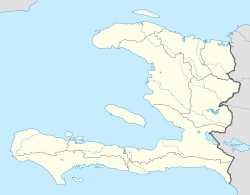Croix des Bouquets
|
Croix-des-Bouquets Kwadèbouke |
|
|---|---|
| Commune | |
| Location in Haiti | |
| Coordinates: 18°34′34″N 72°13′37″W / 18.57611°N 72.22694°WCoordinates: 18°34′34″N 72°13′37″W / 18.57611°N 72.22694°W | |
| Country |
|
| Department | Ouest |
| Arrondissement | Croix-des-Bouquets |
| Area | |
| • Total | 5.46 km2 (2.11 sq mi) |
| Elevation | 64 m (210 ft) |
| Population (2009) | |
| • Total | 284,812 |
| • Density | 52,000/km2 (140,000/sq mi) |
Croix-des-Bouquets (Haitian Creole: Kwadèbouke) is a commune in the Ouest department of Haiti. It is located 12.9 kilometers (8.0 mi) to the northeast of Haiti's capital city, Port-au-Prince. Originally located on the shore, it was relocated inland after the 1770 Port-au-Prince earthquake. Due to this fact, it was not as badly affected in the 2010 Haiti earthquake. The city will be home to refugee tent villages of about 10,000 refugees each when the first wave of refugees begins to be resettled there.
Croix-des-Bouquets is a northern suburb in the Port-au-Prince metropolitan area. Haiti is world-famous for its exuberant art, richly influenced by nature, history and religion, both Christian and Vodou. The entire village of Croix des Bouquets is a good example of Haitian creativity - it resonates with the sounds of clanging and banging of the mallets and chisels in the process of transforming raw metal into stunning, and often haunting, iron sculptures. The city of Croix-des-Bouquets is on the Plaine du Cul-de-Sac, where many people grow organic foods such as beans, sweet potato, and corn.
Prior to the 12 January 2010 earthquake, the once crowded city had been restored. The streets had been cleaned up, wholesale merchants and other commerce had been relocated to Port-au-Prince. Retail commerce which once crowded sidewalks downtown now had a dedicated building.
In the wake of the 12 January 2010 quake, the Cuban medical mission set up a field hospital in the region.
One school close by is Anís Zunúzí Bahá'í School to the north east which opened its doors in 1980 which survived the 2010 Haiti earthquake and its staff were cooperating in relief efforts and sharing space and support with neighbors. A clinic was run at the school by a medical team from the United States and Canada. Currently it is a K-10 school and offers classes to transition from Haitian Creole to the French language but also a secondary language in English. The founders of Institution Chrétienne D'Haïti are seeking to build the Université Chrétienne D'Haïti here.
...
Wikipedia

